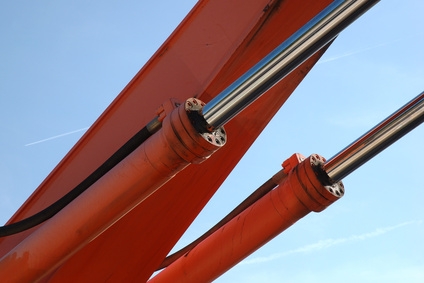
Hydraulic pistons have changed many aspects of our lives. Also called hydraulic cylinders and hydraulic rams, pistons are found in automobiles, aircraft, amusement rides, farm equipment and throughout industry. Due to their simple design, they are often repaired locally or by the do-it-yourself mechanic.
Remove the hoses from each end of the cylinder. The cylinder will contain a volume of hydraulic fluid depending on its diameter and length. Catch the fluid in a container for recycling or proper disposal.
Remove the rod-end cap from the cylinder. Either it threads into the barrel of the cylinder, or a snap ring retainer holds the cap in place. With the end cap loose, slide it down the rod and off the cylinder. Set this part aside for further attention later.
Pull the cylinder rod out of the barrel of the cylinder. A piston connects to the rod and slides up and down within the cylinder bore. Pulling this assembly out of the cylinder housing will expose the piston rings and seals. Set the rod/piston assembly and the cylinder barrel onto a clean surface for further inspection.
Visually inspect the bore of the cylinder housing. If scarring or scratches are present, use a hone and drill to smooth the inside bore. Any scratches on the inside bore of the cylinder will cause the piston rings and seals to wear prematurely, allowing fluid to leak past the piston. With the inside bore of the cylinder honed, clean any debris away with cleaning solvent and a lint-free rag.
Inspect the piston and piston rod. There is no need to remove the piston from the rod, unless the rod is damaged and replacement is necessary. Using a straight edge, check the length of the piston rod to ensure it is true. If the rod is bent or pitted, discard the rod and replace it.
Remove the seals from the piston. A cylinder piston contains anywhere from one to six piston rings, depending on its size and the type of work it performs. The rings separate from the piston with two needle-nosed pliers. Discard the rings. Also, remove the Teflon wiper seals from the piston. These are the white or clear plastic seals on the piston. They remove in the same manner as the piston rings.
Inspect the rod end cap. The cap contains a seal and a rod wiper within a machined recess. Use a scribe or small screwdriver and pry the seal and wiper out of the rod-end cap. Discard the seal and wiper.
Open the new seal kit and place each piece onto a clean cloth on the working surface. Do not get the new seal and rings mixed up with any of the old parts removed from the hydraulic piston. Clean the cylinder rod, piston and end-cap with a cleaning solvent and prepare them for reassembly.
Snap the piston rings onto the piston by hand. The rings separate by slightly pulling them apart and sliding them onto the piston. Install each piston ring in its own piston ring groove. Rotate the piston rings so the openings of each ring are misaligned with the other rings.
Place the Teflon seals onto the piston in the same manner as the rings. Place each seal into its own groove on the piston and slightly rotate. Install a ring compressor onto the seals and piston rings and slide the piston into the cylinder barrel. The ring compressor will line up with the piston barrel and allow the piston and rod to push through into the bore of the cylinder.
Install the new seal and rod wiper onto the recessed grooves of the rod-end cap. It's best when installing by hand. Use care while placing the seals so they are not creased or folded during installation.
Slide the rod-end cap over the cylinder rod and onto the top of the cylinder barrel. Screw the cap onto the barrel or install the snap ring to retain the cap on the cylinder body. Connect the hoses to the cylinder.
Refill the cylinder with hydraulic fluid while bleeding the air from the cylinder through the opposite hydraulic hose. Once all the air is out of the cylinder, tighten both hydraulic hoses to prevent further leaks.